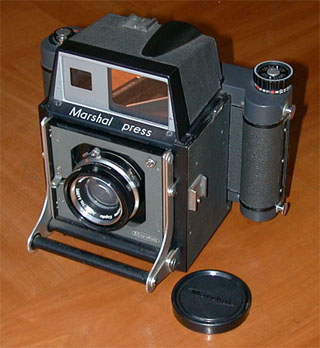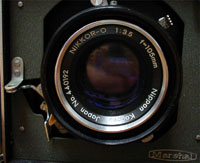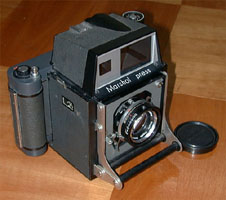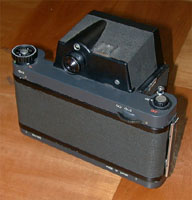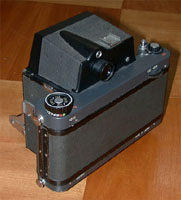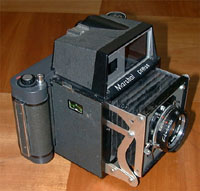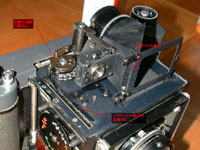
rangefinder coupling (front view)

rangefinder coupling (rear view)
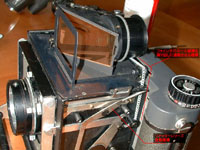
zooming finder
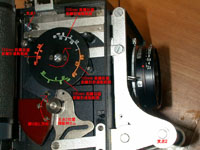
focus at infinity
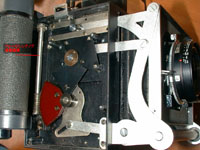
focus at near distance
|
The exterior of the camera looks like Mamiya press, but it is a little bigger than it. Contrary, the film-back is not interchangeable but fixed. The focusing mechanism is so called as "thumb focusing", because a focusing wheel is settled at the position of the thumb of right hand. The scale of distance can be seen through the window of the right side.
The highlight of the camera mechanism is the range finder which couples to all standard 105mm lens and two 135mm and 150mm tele converter. The finder has a zoom optics, and the angle of view is narrowed down when the lens is focused nearer. Simultaneously, the frame mask of the finder moves down cornerways and compensates the parallax. Yes, the both angle and direction of view are managed, so the complete parallax compensation is realized.
Then, the question is how to attach the tele conversion lens. However, you can not find any dials or knobs to do so. Actually, this camera has no switching mechanism to attach the lens, but you can simply extend the bellows more, and you can attach the converter. The bellows can extend over the uncoupled area, and then the masking frame for the parallax compensation goes back to the initial position. Also the range finder returns to the infinity. But the zooming mechanism which narrows the angle of view of the finder works continuously to adapt to new longer focal length. To prevent moving the bellows out of coupled rangefinder limit, ON/OFF dial around the shutter release button can be used.
If you set it to OFF, the bellows can be extend without limit. The dial also works as the infinity stopper when we are using the conversion lens. For example, two tele converter lens extend the standard focal length 105mm to 135mm or 150mm. If you want to use 135mm converter, you must set the limit dial to OFF position at first. Next, extend the bellows to the 135mm area, then return the dial to ON position. After these operation, you can get coupled rangefinder, parallax compensated finder frame, and infinity stop of the focus dial. 150mm converter can be used with same operation.
The current setting can be confirmed from a window above the finder eyepiece. The letter "135" is colored green, and "150" red. Also the focus scale is colored. The orange area of 105mm focus scale is uncoupled rangefinder area. Of course, the converter is not always necessary when extending the bellows, you can take close-up photo by using the long bellows. But you know, the rangefinder does not work for closer than 1m, and focus scale also disappears at closer than 0.6m. For that case, you can use ground glass in the film back. The film back can not be detached, but the film rail can be exchanged to the ground glass or sheet film case.
For those odd function described above, the internal mechanism is a bit complex. In the right-hand of the body, bellows extending mechanism and focus scale is built in. In the opposite side, there are shutter release coupling and zoom finder link, and in the top cover, finder mechanism here. The range finder is coupled by chain to the three rotary cams. The bellows holding mechanism is very particular, a bar and compensating cam keeps the front lens board parallel.
|
